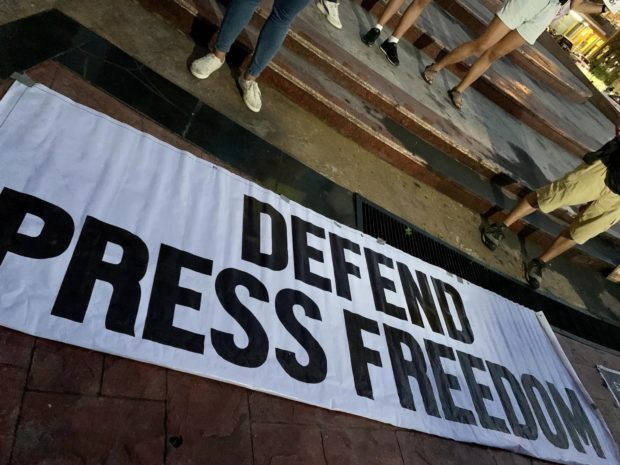State of PH media still ‘largely grim’ – Reuters study

Groups hold an indignation rally to condemn the killing of veteran broadcaster Percival Mabasa, who was more popularly known as Percy Lapid, along Timog Avenue in Quezon City on October 4, 2022. (Photo from Kabataan Partylist’s Facebook oage)
MANILA, Philippines — Red-tagging, killings, and the use of “lawfare” against journalists have not abated in the Philippines even with the change in the country’s leadership, according to the 2023 report by the Reuters Institute released on Wednesday.
The 160-page digital news report by the Reuters Institute for the Study of Journalism includes a country page focusing on the Philippine media situation, authored by veteran journalist and University of the Philippines professor Yvonne Chua.
The country’s media landscape remained “largely grim” despite the change of administration from Rodrigo Duterte to President Marcos, Chua wrote.
“Attacks on journalists, which escalated during the six-year presidency of Rodrigo Duterte, have not let up since Ferdinand Marcos Jr.,” her report noted.
According to Chua, dozens of violations of press freedom have been recorded under the Marcos administration, with 75 cases monitored between June 2022 and April 2023.
She said these included the killing of radio commentator Percival “Percy Lapid” Mabasa in October last year, a crime widely condemned by local and international media organizations as well as foreign dignitaries.
Also cited in the report were the “surprise visits” by policemen in plain clothes to the homes of some reporters, as exposed by TV reporter JP Soriano, raising fears among Filipino journalists that they were under government surveillance.
The “systematic Red-tagging” of journalists also persisted, according to the report, targeting both those in mainstream and alternative media organizations, such as ABS-CBN, GMA Network, Philippine Daily Inquirer, Rappler, Bulatlat and community paper Northern Dispatch.
Red-tagging in the Philippine context refers to the marking of a person or group as a supporter or sympathizer of the communist insurgency, often with no proof, exposing them to prosecution or physical harm. A number of red-tagged activists have been killed.
Members of the National Union of Journalists of the Philippines (NUJP) are among those who have faced red-tagging, which the Reuters report said was led by the “far-right” broadcast network Sonshine Media Network International owned by televangelist Apollo Quiboloy, a staunch supporter of Duterte and Marcos.
The use of “lawfare” or legal action against Filipino reporters, has also increased, Chua reported, prompting NUJP to team up with lawyers in launching “Project Lawfare” to defend journalists from lawsuits.
Reached for comment, the executive director of the Presidential Task Force on Media Security (PTFoMS), Paul Gutierrez, called the Reuters report “false.”
“Let us not glorify the statements of foreign orgs [sic] who, in their arrogance, always believe they know better than us,” said Gutierrez, a former president of the National Press Club.
“Is there really such description [of red-tagging] in our laws and jurisprudence? None. [It] is a term concocted by front orgs of the [Communist Party of the Philippines-National Democratic Front of the Philippines-New People’s Army] to protect their front orgs from exposure,” he said.
While “media killing is truly reprehensible and must be condemned,” he said, “our judicial system is working, even in the Percy Lapid case. The suspects, including the alleged mastermind, have been identified, charged in court, and remain the subject of ongoing manhunt.”
“While media repression and killings remain a problem, the important thing is (that) government is continuously addressing these issues as evidenced (by Mr. Marcos’) decision to continue with PTFoMS. Let us give credit where credit is due,” Gutierrez said.
Trust ratings
The report also assessed the popularity of the major news outlets and platforms.
Radio and television “remain the most popular media overall,” with GMA Network having the “dominant audience share.”
“Many of the longest established media brands, such as GMA Network and the Philippine Daily Inquirer, have relatively high levels of trust,” the report noted.
Trust in the news has been boosted “to some extent” by the COVID-19 pandemic, with many Filipinos coming to rely more on news media, it added.
Philippine media in general gained an overall trust rating of 38 percent in 2023, growing from 27 percent in 2020.
Based on the trust scores per brand, GMA Network got the highest at 74 percent, followed by newspapers Inquirer, Manila Bulletin, and the Philippine Star; radio stations dzRH and dzBB, and TV5 network — all at 68 percent.
However, some independent media outlets, which are “respected for their reporting” on people in power, were “often actively” distrusted by supporters of the powerful politicians in question.
Such media organizations were also subjected to coordinated harassment, according to the report.
An example cited was the online news site Rappler, which obtained a trust rating of 47 percent and a distrust rating of 11 percent.
Online sites and social media, the Reuters report added, were the “most popular” sources of news in the country while TV and radio news “remain important” to those who were not online.
TikTok, the report said, has “grown the fastest” among social media platforms, being accessed now by 21 percent of news consumers compared to only 2 percent in 2020.